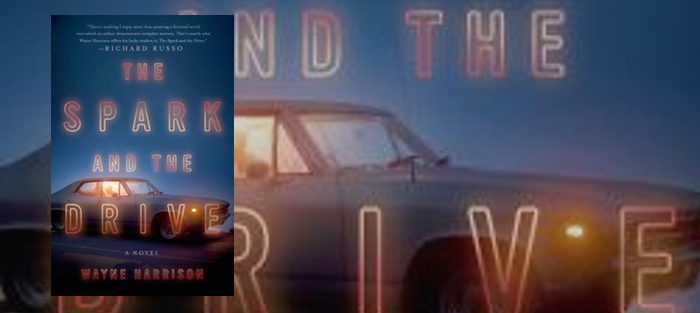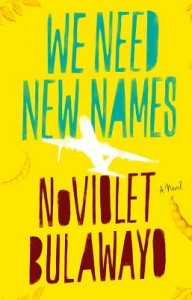Wayne Harrison’s short story “Least Resistance” was first selected by The Atlantic for publication, then by Richard Russo for inclusion in Best American Short Stories 2010, and then by me for the little star I append every year to my favorite stories from that anthology. Each of these selections are largely, if not purely, subjective, of course, but the writers who manage to earn all of them become, for me, reference points and celebrities. So you can imagine my excitement when I learned that Harrison’s debut novel, The Spark and the Drive, released July 15 by St. Martin’s Press, was developed from the story that had earned my star. Not only did I get to read more of it, but I also got to witness its evolution from one form to another.
In both forms, the story centers on an auto shop in the 1980s that is famous for enhancing and maintaining muscle cars. The narrative follows a bright teenaged boy, Justin, who, instead of entering college, catches on as an auto mechanic, and then finds himself participating in a world of cars and human relationships that are complicated beyond his understanding. He venerates the shop owner, an automotive genius named Nick, who also stands in as a father for him. After a tragedy knocks Nick’s marriage off-kilter, Justin becomes involved with Nick’s wife, Mary Ann, and is afterward torn between his loyalties to the two people he loves and admires most.
Like the short story, the novel is devoted mostly to the human drama that leads into and comes out of this dilemma, but it offers new pleasures, as well. It’s an exciting book, full of high-stakes drag races, dangerous driving, crimes and betrayals, and gut-wrenching close calls, all rendered with Harrison’s literary sensibilities, so that readers get to feel the thrust of acceleration, the bodily sensations of fear, the moral dangers that accompany the physical risks.
It’s also a sexy book. Harrison adds a number of love scenes between Justin and Mary Ann, then carries through them rather than modestly cutting away as soon as the first button is undone, as many other writers do. These scenes are handled tastefully, but they don’t flinch away from the intimate details, sensations, and emotions of sex. And that’s not the only thing that makes the book sexy. I’m not a car enthusiast myself, but most of the characters are, and their expertise helped me appreciate the smooth bodies and powerful engines they come across. Harrison’s descriptions are imbued with their passion and intimate knowledge, as when Justin returns to the shop a few months after his internship to see about a real job:
I walked past a metallic blue Barracuda, a candy-apple Firebird, a ragtop Challenger. Even seeing them parked was, by the artistry of their designers, like seeing them move—burying their speedometers or laying rubber up a city block. Long hoods and short decks, elevated rear fenders and wide racing stripes. They looked like resting dragons.
The characters’ expertise is, of course, rooted in the author’s. As a former mechanic and a graduate of the Iowa Writers’ Workshop, Harrison is in a unique position to provide a detailed view of the work and culture in an American auto shop. The talk there is coarse, full of jargon and specialized knowledge, but Harrison keeps it all accessible in ways that are never intrusive or inauthentic.
What pleases me most, however, is that the novel doesn’t read like an unnecessary or empty duplication of the short story. Harrison achieves a much different effect, in part because of the formal changes he has implemented. The short story begins en medias res, with Justin already embedded at the shop, the affair in full swing. This is, of course, what makes a story short. Instead of using several full-blown scenes to establish the characters and conflicts, Harrison can dip back to only the pivotal moments, stripped of anything superfluous, to fill out the front story’s action. Freed from the constraints of chronology, he can provide a powerful detail, gesture, line of dialogue, and then race off to other key moments. This is what allows the story its muscle and precision. It’s like a hotrod burning through a quarter mile, and we get to see a skillful driver open up the throttle.
But this moment-by-moment intensity would be exhausting on a longer road trip, and so the novel, after a brief retrospective preface, is largely chronological, allowing a more comfortable, leisurely pace. It starts with Justin arriving at the auto shop for an internship a year before he graduates high school, then builds one scene on top of another, introducing, developing, and complicating the characters and conflicts little by little. This allows Harrison to expand these elements, infusing the narrative with the richness and depth that distinguish a novel’s orchestral power from a story’s spare beauty.
It also allows for a bigger story, and Harrison provides one by adding several interesting elements and complications. One is the arrival of an incredible, all-aluminum ZL-1 Corvette, one of two in existence and maybe the fastest car ever built, with which Justin and Nick bond and test themselves in new ways. Another is Holy Land USA, an old amusement park that has become an abandoned wreckage of religious monuments. Minor characters in the short story, such as Tommy the Tantrum (now named Bobby), become major characters in the novel, complete with histories and agendas that collide with those of the other characters. Justin’s home life and parents, absent from the story, get full development in the novel.
Maybe most interestingly, Harrison adds a more specific historical context—new regulations from the Environmental Protection Agency in the 1970s have effectively shut down muscle car production, and the entire industry is undergoing a transformation, putting Nick’s specialized auto shop on shaky ground. Nick sums up the new challenge for his mechanics:
“You can’t bore and stroke [a new engine], or so long emissions [standards]. It’s going to be technology. Computer chips, sensors. Guys that only know carburetors are going to be dinosaurs.”
We see the beginnings of this transformation when a customer brings in a newer TransAm, and a mechanic, Ray, opens the hood on an engine “choked with hoses and vacuum lines for smog control. You couldn’t even see the spark plug boots.” When the customer complains of sluggishness, recalling the power of an old neighbor’s Super Commando, Ray interrupts:
“Okay, let me stop you right there, chief. A big Mopar and this you got here have zero in common. Zero. You ever want to break the speed limit in this boat, yank out that smog motor and invest in a four-bolt small block. End of story.”
The contempt from Ray and the other mechanics doesn’t just come from the performance decline or the customer’s ignorance. It also comes from defensiveness. These industry changes put them on the edge of obsolescence. Like Nick and Mary Ann after their tragedy, like Justin after high school, their old world has vanished, and they are being forced to confront a new one. That’s what The Spark and the Drive is essentially about: the ability—or inability—to make one’s way in a transforming world, one that becomes unrecognizable not just from new regulations, but also from love, error, adulthood, and loss.






